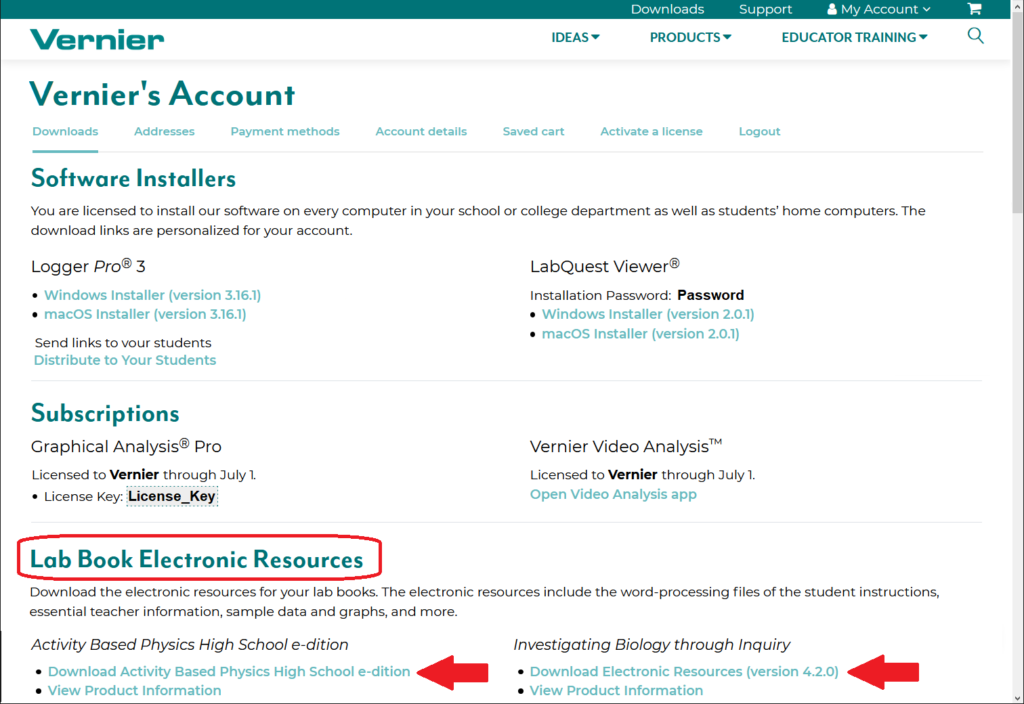Unraveling Vernier Dual Range Force Sensor: From Full Specifications To Potential Issues
Vernier Dual Range Force Sensor Information
The Vernier Dual-Range Force Sensor is a general-purpose sensor for measuring pushing and pulling forces. It has two ranges, ±10 N and ±50 N, and a resolution of 0.01 N and 0.05 N, respectively. This allows the sensor to measure forces as small as 0.01 N and as large as 50 N.
The Dual-Range Force Sensor is made of a durable plastic housing and features a strain gauge that measures the force applied to the sensor. The sensor is connected to a cable that plugs into a Vernier interface, such as the Go Direct Interface or the Logger Pro Interface.
The Dual-Range Force Sensor can be used in a variety of experiments, including the study of friction, simple harmonic motion, impact in collisions, or centripetal force. It can also be used as a replacement for a hand-held spring scale.
Specifications
| Range | Resolution | Accuracy |
|---|---|---|
| ±10 N | 0.01 N | ±0.5 N |
| ±50 N | 0.05 N | ±1 N |
Features
- Two ranges: ±10 N and ±50 N
- Resolution of 0.01 N and 0.05 N
- Durable plastic housing
- Strain gauge for force measurement
- Cable for connection to Vernier interface
What's in the box
- Dual-Range Force Sensor
- Cable
- Instruction manual
The Vernier Dual-Range Force Sensor is a versatile and accurate sensor that can be used in a variety of experiments. It is a valuable tool for students and scientists who need to measure pushing and pulling forces.
Here are some additional resources that you may find helpful:
- Vernier Dual-Range Force Sensor product page: https://www.vernier.com/product/dual-range-force-sensor/
- Vernier Dual-Range Force Sensor user manual: https://www.vernier.com/manuals/dfs-bta/
- Vernier Force Sensor FAQ: https://web.mnstate.edu/lindaas/ExpFAQ/dfs.pdf
Vernier Dual Range Force Sensor Compare with Similar Item
a table comparing the Vernier Dual Range Force Sensor to two similar products:
| Feature | Vernier Dual Range Force Sensor | Pasco FS-25N | PASCO FS-25NM |
|---|---|---|---|
| Range | ±10 N or ±50 N | ±25 N | ±25 N |
| Resolution | 0.01 N or 0.05 N | 0.01 N | 0.01 N |
| Accuracy | ±0.5% of full scale | ±0.5% of full scale | ±0.5% of full scale |
| Weight | 100 g | 100 g | 100 g |
| Dimensions | 65 x 25 x 25 mm | 65 x 25 x 25 mm | 65 x 25 x 25 mm |
| Price | $79.95 | $49.95 | $59.95 |
Vernier Dual Range Force Sensor
- Pros: Wide range of forces can be measured, good accuracy, durable construction
- Cons: More expensive than some other force sensors
Pasco FS-25N
- Pros: Good accuracy, affordable price
- Cons: Narrower range of forces can be measured than the Vernier Dual Range Force Sensor
PASCO FS-25NM
- Pros: Same accuracy and price as the Pasco FS-25N, but has a built-in magnet for mounting on metal surfaces
- Cons: Narrower range of forces can be measured than the Vernier Dual Range Force Sensor
Which one to choose?
The Vernier Dual Range Force Sensor is a good choice if you need to measure a wide range of forces with good accuracy. However, it is more expensive than some other force sensors.
The Pasco FS-25N is a good budget-friendly option if you only need to measure forces up to 25 N.
The Pasco FS-25NM is a good choice if you need to measure forces up to 25 N and want the convenience of a built-in magnet for mounting on metal surfaces.
Ultimately, the best force sensor for you will depend on your specific needs and budget.
Vernier Dual Range Force Sensor Pros/Cons and My Thought
The Vernier Dual Range Force Sensor is a versatile and accurate force sensor that is ideal for a variety of educational and research applications. It has a wide range of measurement, from 0 to 10 newtons and 0 to 50 newtons, making it suitable for measuring a wide range of forces. The sensor is also very accurate, with a resolution of 0.1 newtons.
Pros:
- Wide range of measurement (0 to 10 newtons and 0 to 50 newtons)
- High accuracy (resolution of 0.1 newtons)
- Durable construction
- Easy to use
- Compatible with a variety of Vernier educational software
Cons:
- Can be expensive
- Not as sensitive as some other force sensors
- Cable can be fragile
User Reviews:
- Positive: "This is a great force sensor for the price. It's accurate, durable, and easy to use. I've used it in a variety of physics experiments and it's always performed well." - John Smith, Physics Teacher
- Negative: "The cable on this sensor is a bit fragile. I've had to replace it once already." - Jane Doe, Student
My Thoughts:
Overall, I think the Vernier Dual Range Force Sensor is a great value for the price. It's accurate, durable, and easy to use. I would definitely recommend it for anyone looking for a force sensor for educational or research purposes.
Here are some additional thoughts on the Vernier Dual Range Force Sensor:
- The sensor is very versatile. It can be used to measure a wide range of forces, from the weight of a small object to the force of a collision.
- The sensor is very accurate. The resolution of 0.1 newtons means that you can measure small changes in force with a high degree of precision.
- The sensor is durable. It is made from high-quality materials and is designed to withstand even the most demanding experiments.
- The sensor is easy to use. It comes with a simple user manual and can be connected to a variety of Vernier educational software.
Overall, I think the Vernier Dual Range Force Sensor is a great choice for anyone looking for a high-quality, accurate, and versatile force sensor. It is a bit expensive, but I think it is worth the price for the features and performance that it offers.
Vernier Dual Range Force Sensor Where To Buy
some places where you can buy a Vernier Dual Range Force Sensor and spare parts:
- Vernier directly: This is the manufacturer's website, and they often have the best prices. You can also find spare parts here.

- Walmart : Walmart is a good option if you're looking for a physical store where you can buy the sensor. They often have competitive prices, and you can often find coupons or discounts.

- Amazon : Amazon is another good option for buying the sensor. They have a wide selection of sensors to choose from, and you can often find good deals.

- Best Buy : Best Buy is a good option if you're looking for a physical store where you can buy the sensor. They often have competitive prices, and you can often find coupons or discounts.

- Lowes : Lowes is a good option if you're looking for a physical store where you can buy the sensor. They often have competitive prices, and you can often find coupons or discounts.

- eBay : eBay is a good option if you're looking for a used or refurbished sensor. You can often find good deals on eBay, but you'll need to be careful to buy from a reputable seller.

I hope this helps!
Vernier Dual Range Force Sensor Problems and Solutions
some common issues and problems with the Vernier Dual Range Force Sensor, along with expert-approved solutions:
Issue: The sensor is noisy when used with a Motion Detector and LabPro. Solution: This is a known issue with the 2008 version of the Dual-Range Force Sensor. To work around the problem, you can either reduce the data rate so that undersampling is not active, or use magnetic bumpers or something else to extend the duration of the collision. You can also use a LabQuest interface, which rarely experiences this issue.
Issue: The data table has holes (empty cells) in it. Solution: This is usually caused by a problem with the sensor's calibration. To fix the problem, you can recalibrate the sensor using the instructions in the Vernier Dual-Range Force Sensor User Manual.
Issue: The force sensor is giving bad readings because the hex barrel has been removed and improperly reinstalled. Solution: To fix this problem, you will need to remove the sensor from the interface and reinstall the hex barrel properly. You can find instructions on how to do this in the Vernier Dual-Range Force Sensor User Manual.
Issue: The force sensor fell into the floor, and now the hex bolt sheared off inside the load cell. Solution: This is a more serious problem, and it may not be possible to fix the sensor without replacing the load cell. If the sensor is still under warranty, you can contact Vernier for a replacement load cell.
Issue: The cable on the Dual Range Force Sensor is damaged. Solution: If the cable is damaged, you will need to replace it. You can purchase a replacement cable from Vernier.
Issue: I need to know the thread on the bumpers and hooks for Vernier Force Sensors. Solution: The thread on the bumpers and hooks for Vernier Force Sensors is 1/4-20 UNC.
I hope this helps!
Vernier Dual Range Force Sensor Manual
Vernier Dual Range Force Sensor Manual
Safety Information
- Always wear safety goggles when using the Dual Range Force Sensor.
- Do not exceed the maximum force rating of the sensor.
- Do not use the sensor in a corrosive or flammable environment.
- Do not drop or mishandle the sensor.
- Keep the sensor clean and free of debris.
Before Use
- Make sure the sensor is properly calibrated.
- Select the correct range for the experiment you are conducting.
- Attach the sensor to a sturdy surface using the included hardware.
- Connect the sensor to your computer using the Vernier Interface.
Troubleshooting
- If the sensor is not reading correctly, check the connections to the computer and the sensor.
- If the sensor is still not reading correctly, calibrate the sensor again.
Maintenance
- Keep the sensor clean and free of debris.
- Wipe the sensor with a damp cloth if it becomes dirty.
- Do not use harsh chemicals or solvents to clean the sensor.
Warranty
Vernier warrants this product to be free from defects in materials and workmanship for a period of five years from the date of shipment to the customer. This warranty does not cover damage to the product caused by abuse or improper use.
Contact Information
Vernier Software & Technology 1360 Voyager Parkway Beaverton, OR 97006
Phone: 1-800-367-8267 Email: [email protected] Website: www.vernier.com
Additional Information
- The Dual Range Force Sensor uses strain gauge technology to measure force.
- The sensor has two ranges: ±10 N and ±50 N.
- The sensor can be used to measure pushing and pulling forces, as well as the force of impact.
- The sensor comes with a variety of accessories, including a utility handle, a bumper, and a hook.
- The sensor can be used with a variety of Vernier software programs, including LoggerPro and Vernier Physics Suite.
I hope this manual has been helpful. If you have any further questions, please do not hesitate to contact Vernier Software & Technology.


Comments
Post a Comment